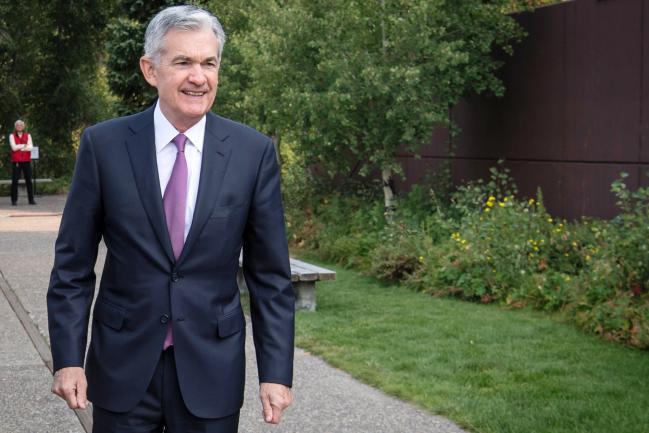(Bloomberg) -- Jerome Powell laid out a doctrine of basing monetary policy on evidence from the economy alongside theoretical models as the foundation of his young tenure as Federal Reserve chairman, with the U.S. central bank entering a crucial period in the business cycle.
In his first speech as Fed chief at an annual conference in Jackson Hole, Wyoming, Powell defended his a gradualist approach and, in the process, hardened expectations for a September interest-rate increase. He stressed that estimates of how the economy works -- like those followed by Ph.D. economists on the Fed staff -- were at best “hazy” navigational guides. As a result, they need to be tested by close observation of real economic data.
“What I do see here is an affirmation of the Powell Doctrine: We’ve got a framework of the way the world works, we have these estimates, but they are subject to imprecision,” said Michael Gapen, chief U.S. economist at Barclays (LON:BARC) Plc in New York. “He is going to talk a little plainer, acknowledge uncertainty, and fashion a policy around that.”
Shifting Stars
Powell used the term “shifting stars” several times in his speech Friday at the Kansas City Fed’s annual policy symposium in Wyoming’s Grand Teton National Park, referring to the guideposts in economic models often symbolized with an asterisk, or “star.”
The Federal Open Market Committee’s job, as Powell defined it, is to be aware of how these estimates are changing and not take them as set in stone. The chairman reminded his audience of central bankers and economists that if the Fed stubbornly tried to defend a previous estimate for full employment -- a term economists refer to as U-star -- the cost would be 1.6 million jobs.
“He is crystal clear here that while he understands that all those economic principals are important, he is not going to let current estimates of those things be the dominant driver of interest rates,” said Robert Martin, executive director at UBS Securities LLC and a former Fed board staff economist. “This is the same message we got from his press conferences. He is going to let policy be governed by the current state of the economy.”
Investors have fully priced in a rate increase next month and see an above-60 percent probability of another move by the Fed’s meeting in December.
Strong Performance
The Fed chairman said he expected the economy’s “strong performance will continue” and as a result the Fed’s “gradual process of normalization remains appropriate.”
The word “normalization” is significant in that it signals the central bank, even with the economy now in its 10th year of expansion, is still returning policy to something more consistent with a neutral interest rate, or one that doesn’t slow or stimulate the economy.
Even so, the policy has attracted the ire of President Donald Trump, who nominated Powell to the top Fed job and has since complained about his rate hikes.
Powell’s discussion of the challenges of monetary policy at a time of uncertainty is an introduction to his chairmanship and how different it will be from his predecessors.
Under chairs Ben Bernanke and Janet Yellen, the case for holding off on rate hikes was simple as the unemployment rate declined from a devastating peak of 10 percent in 2009 with an economy still scarred by the financial crisis.
Powell took over from Yellen in February in the midst of a mature expansion that was given a big boost by Republican tax cuts and a higher federal spending. Unemployment stood at 3.9 percent in July, well below 4.5 percent that the Fed sees as consistent with full employment in the longer run. Still, central bankers have shown patience, raising rates at a careful pace while inflation has slowly moved higher.
Policy Mistake
Powell said the FOMC must balance the threat of moving too fast and shortening the expansion, or moving too slowly and allowing for overheating.
“I see the current path of gradually raising interest rates as the FOMC’s approach to taking seriously both of these risks,” Powell said. While unemployment is low, “there does not seem to be an elevated risk of overheating.”
“This is good news, and we believe that this good news results in part from the ongoing normalization process, which has moved the stance of policy gradually,” Powell said. “If the strong growth in income and jobs continues, further gradual increases in the target range for the federal funds rate will likely be appropriate.”
The fulcrum of Powell’s policy is straight out of modern economic theory -- keeping inflation expectations low and stable. Measures of what the public expects longer-run inflation to be can be somewhat hazy, but most gauges show them at low and stable rates. If they ever broke free, the Fed would act aggressively.
“I am confident that the FOMC would resolutely ‘do whatever it takes’ should inflation expectations drift materially up or down or should crisis again threaten,” Powell said.
“The takeaway for policy management under Powell is that you may want to be cautious about moving preemptively when you don’t know what the structure of the economy is and what the distribution of risks are,” said Lou Crandall, chief economist at Wrightson ICAP (LON:NXGN) LLC. “But once the dangers start to manifest themselves, you move very aggressively, rather than conservatively.”
